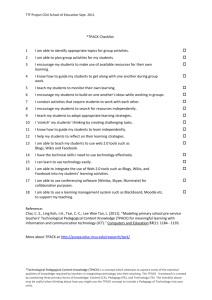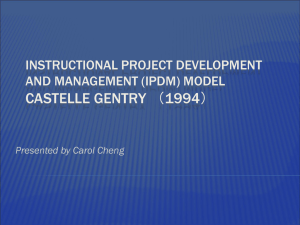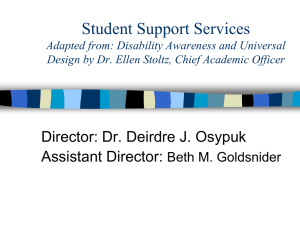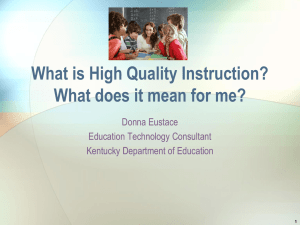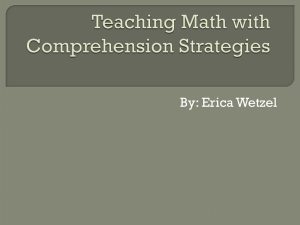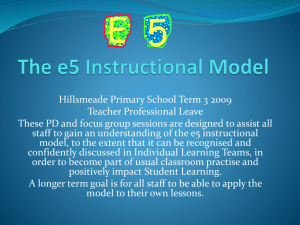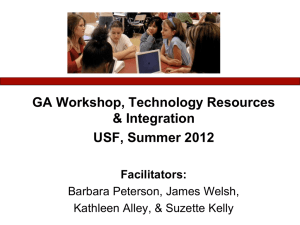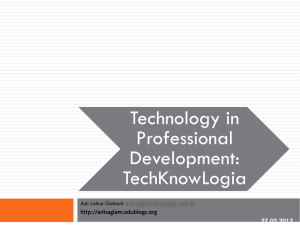Teaching and The Human Braine
advertisement
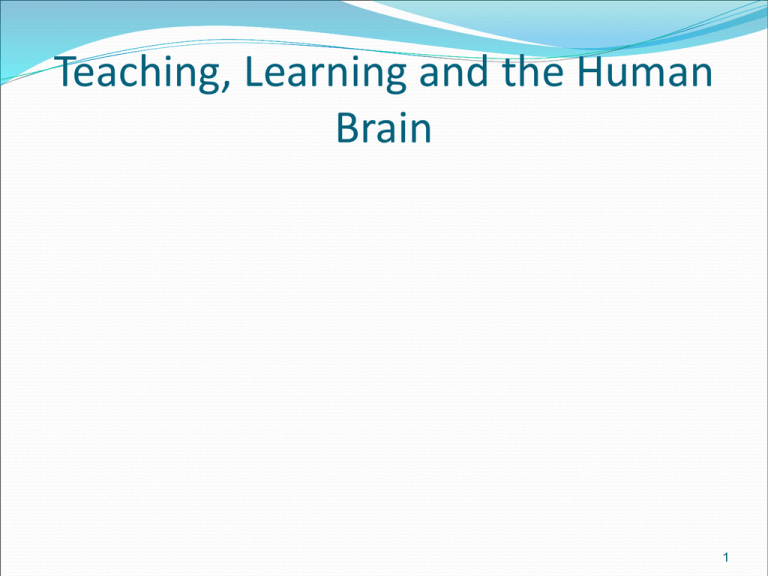
Teaching, Learning and the Human Brain 1 Placing Teaching in the Context of Learning “The human brain/mind is like a dynamic kaleidoscope. The neurosciences are telling us that, energized by genetics, experience and culture, students literally learn from everything.” Caine et al., p. 1 2 Placing Teaching in the Context of Learning As educators and future administrators, we have begun to see what this generation of students is learning beyond the classroom and is unlike anything that past generations have experienced due to the technological revolution… We often find ourselves caught between the world of the past that has a sense of order and security for us, and the world of the future that is filled with ambiguity and uncertainty…. Thoughts taken from Caine et al. for slides 3 -19 3 A Definition of Learning Based on 12 Principles All learning is physiological. The brain/mind is social. The search for meaning is innate. The search for meaning occurs through patterning. Emotions are critical to patterning. The brain/mind processes parts and wholes simultaneously. 4 A Definition of Learning Based on 12 Principles Continued Learning involves both focused attention and peripheral perception. Learning always involves conscious and unconscious processes. There are at least two approaches to memory: archiving isolated facts or making sense of experience. Learning is developmental. Complex learning is enhanced by challenge and inhibited by threat associated with helplessness. Each brain is uniquely organized. 5 From Learning to Teaching 1. Relaxed Alertness: Creating the Optimal Emotional Climate for Learning 2. Orchestrated Immersion in Complex Experiences: Creating Optimal Opportunities for Learning 3. Active Processing of Experience: Creating Optimal Ways to Consolidate Learning 6 Brain/Mind Learning Capacities Creating an Enriched Environment for Learning Engage the physiology in learning Engage social interactions Engage their innate search for meaning Engage their capacity to recognize and master essential patterns Engage emotional connections Engage their ability to perceive both detail and the larger view Engage both their ability to focus attention and learn from the peripheral context 7 Brain/Mind Learning Capacities Creating an Enriched Environment for Learning Engage both conscious and unconscious processing Engage their capacity to learn from memorizing isolated facts and biographical events Acknowledge and engage developmental steps and shifts Reduce threat and enhance self-efficacy Engage their individual style and uniqueness 8 What are we after as teachers and teacher leaders? Developing the Executive Functions The key to reaching and sustaining high standards of learning, and continually raising those standards over time… 9 Executive Functions Individuals with highly developed executive functions have mastered the ability to: Plan and organize their thinking Use reason Engage in risk assessment Make sense of ideas and behavior Multitask 10 Executive Functions Moderate emotions Work with longer time horizons Think critically Access working memory Reflect on their own strengths and weaknesses 11 Executive Functions These functions of the brain go way beyond discrete, memorized skills or information. This is often sabotaged by children’s social/emotional environment and is often bypassed by traditional teaching… 12 Scaffolding the Journey Three Instructional Approaches Instructional Approach 1 View of Learning: Memorization of facts and skills, and veridical decision making 13 Instructional Approach 1 Instruction: Largely focused on teacher presentations followed by repetition and practice Academic Goals: Completion of assigned work, high grades based on teacher judgment and standards Assessment: Standardized Tests 14 Scaffolding the Journey Three Instructional Approaches Instructional Approach 2 View of Learning: Intellectual Understanding supplemented by memorization, with some opportunities for adaptive decision making 15 Instructional Approach 2 Instruction: Teacher-led experiences orchestrated around concepts and meaning; include student choices and input on assignments, class rules and assessment (example: rubrics) Academic Goals: Mastering, Curriculum and Standards Assessment: Authentic assessment supplements standardized tests 16 Scaffolding the Journey Three Instructional Approaches Instructional Approach 3 View of Learning: Understanding in order to make sense of experience, with strong emphasis on adaptive decision making and development of executive functions 17 Instructional Approach 3 Instruction: Real-world projects with curriculum embedded, driven by student choices and interests Academic Goals: Going beyond academic school standards through ongoing, authentic questioning, investigation, and documentation based on experts in the field Assessment: Authentic performance of all kinds 18 Idea is for teachers and teacher leaders to walk the path from Instructional Approach 1 to 3 This is a transformational process… Engage students in cooperative projects that require research, higher order thinking, problem solving, planning and participating in defining and reaching the highest standards. Include additional abilities such as dealing with emotions to help become socially mature and adept… 19 Doing Math Kindt et al, 2006 How much do all 3 chickens weigh? Each chicken? 20 Pedagogical Content Knowledge Lee Shulman, 1986, pp. 9-10 For the most regularly taught topics in one’s subject area: The most useful representations of ideas The most powerful analogies, illustrations, examples and demonstrations Ways of representing and formulating the subject that make it comprehensible to others A collection of resources of alternative forms of representation Understanding of why certain concepts are easy or difficult to learn 21 Mathematical Knowledge for Teaching Deborah Ball & Hyman Bass, 2000 “a kind of understanding ..not something a mathematician would have, but neither would be part of a high school social studies’ teacher’s knowledge” “teaching is a form of mathematical work… involves a steady stream of mathematical problems that teachers must solve” Features include: unpacked knowledge, connectedness across mathematical domains and over time (seeing mathematical horizons) 22 Mathematical Knowledge for Teaching Trimming- making mathematics available yet retaining mathematical integrity Unpacking-making the math explicit Making connections visible- within and across mathematical domains Using visualization to scaffold learning Considering curricular trajectories Flexibly moving among strategies/ approaches adapted from Ferrini-Mundy et al, 2004 23 Technological Pedagogical Content Knowledge (TPACK) “Technological Pedagogical Content Knowledge (TPACK) attempts to capture some of the essential qualities of knowledge required by teachers for technology integration in their teaching, while addressing the complex, multifaceted and situated nature of teacher knowledge. At the heart of the TPACK framework, is the complex interplay of three primary forms of knowledge: Content (CK), Pedagogy (PK), and Technology (TK).” See Figure below. As must be clear, the TPACK framework builds on Shulman's idea of Pedagogical Content Knowledge. 24 TPACK www.tpck.org 25 Polya’s Ten Commandments Be interested in the subject Know the subject Know about ways of learning Let students learn guessing Let students learn proving Look at features of problems that suggest solution methods (Polya, 1965,p. 116) 26 Polya’s Ten Commandments Read faces of students Give students “know how”, attitudes of mind, habit of methodical work Let students guess before you tell them Suggest it; do not force it down their throats (Polya, 1965, p. 116) http://orangemath.blogspot.com/2009/08/ten-commandments-for- teachers-george.html 27 References • Ball, D.L. & Bass, H. (2000). Interweaving content and pedagogy in teaching and learning to teach: Knowing and using mathematics. In J. • Burrill, G. (2004). “Mathematical Tasks that Promote Thinking and Reasoning: The Case of Farmer Jack” in Mathematik lehren • Caine, R. N.,Caine G., McClintic, C.,& Klimek, K. (2005). Brain/Mind Learning Principles in Action. Ferrini-Mundy, J., Floden, R., McCrory, Burrill, G., & Sandhow, D. (2004). Knowledge for teaching school algebra: challenges in developing in analytic framework. unpublished paper 28 References Kindt, M., Abels, M., Meyer, M., Pligge, M. (2006). Comparing Quantities. In Wisconsin Center for Education Research & Freudenthal Institute (Eds.), Mathematics in context. Chicago: Encyclopedia Britannica Polya, G. (1965). Mathematical discovery: On understanding, learning, and teaching problem solving. Shulman, L.S. (1986). Those who understand: Knowledge growth in teaching. Educational Researcher. 15 (2): 4 - 14. 29

